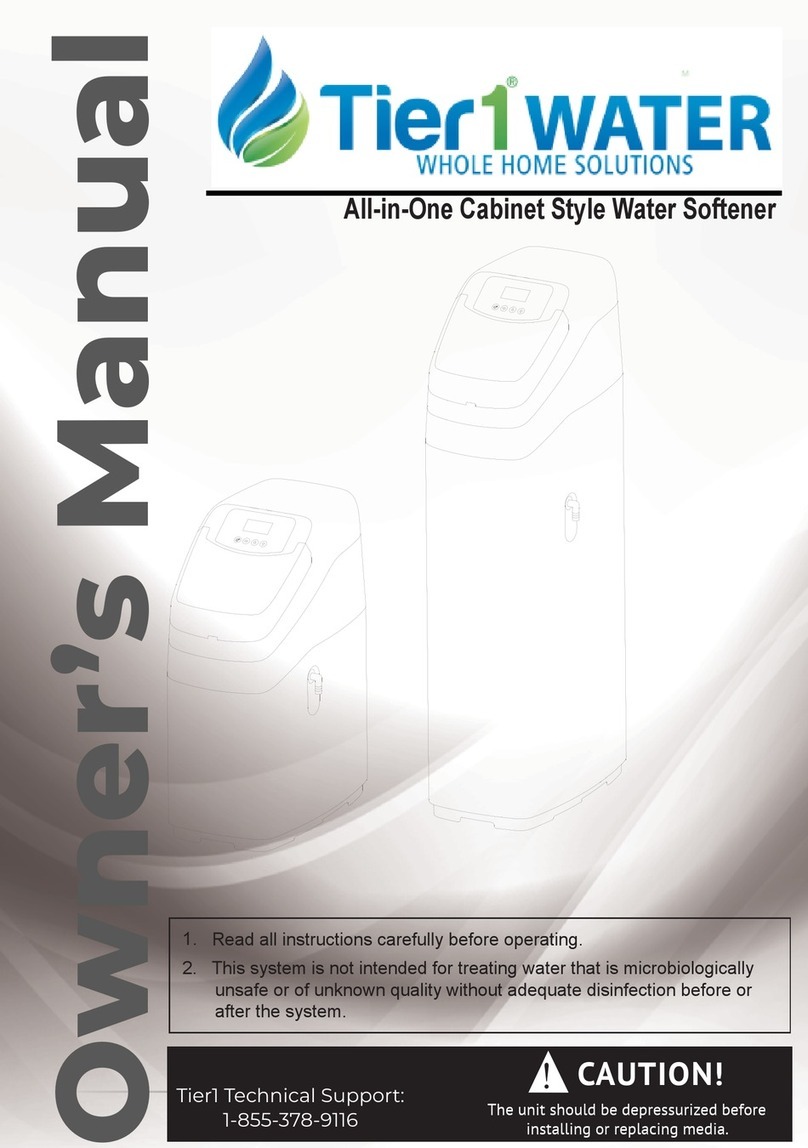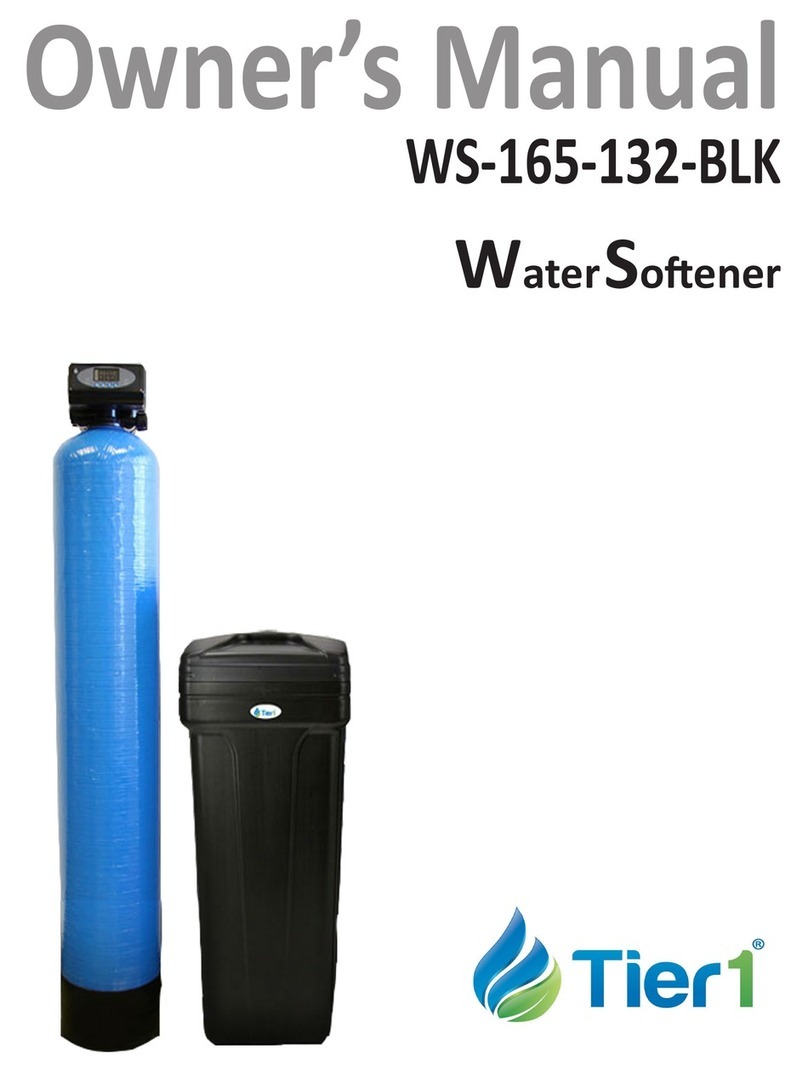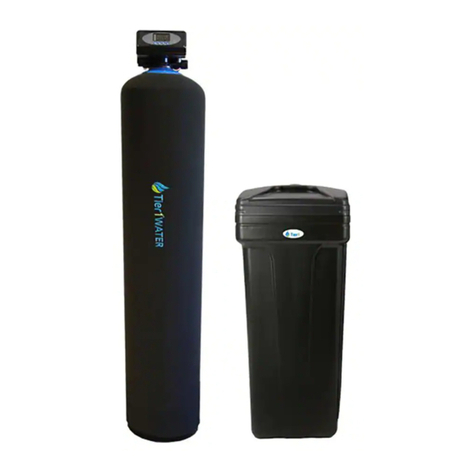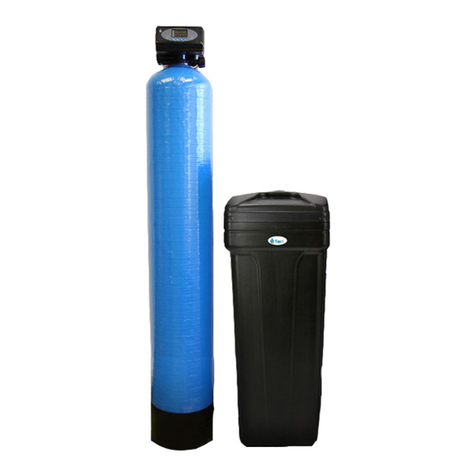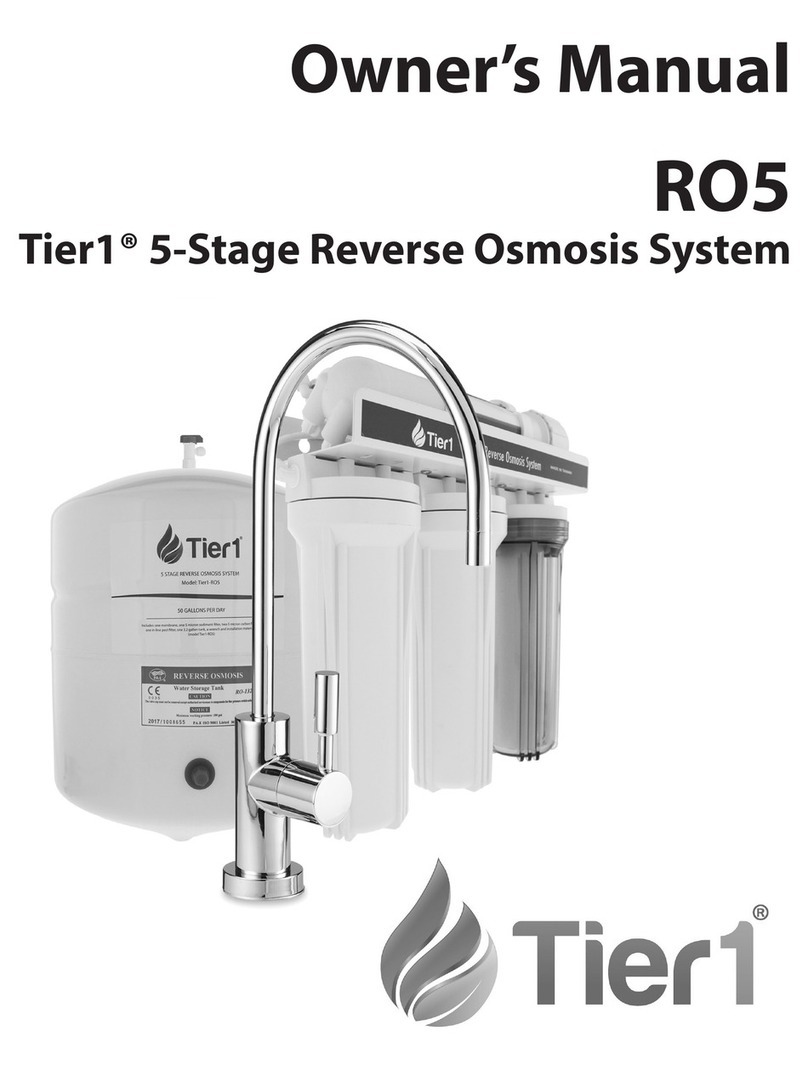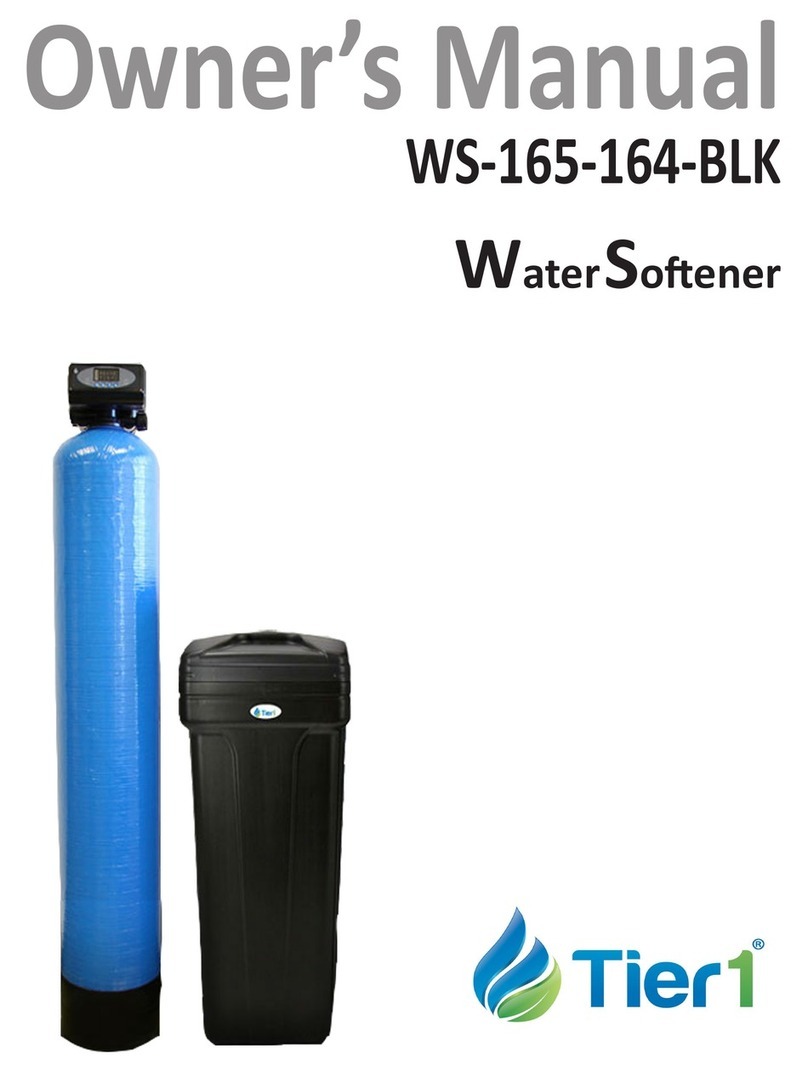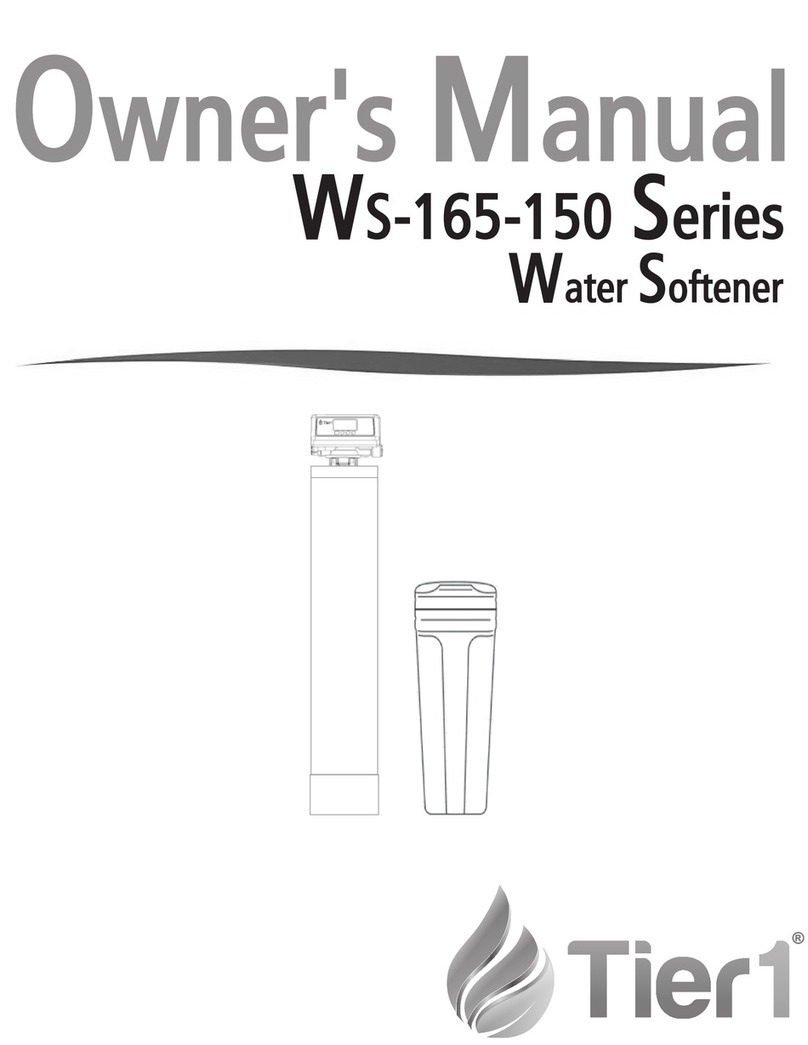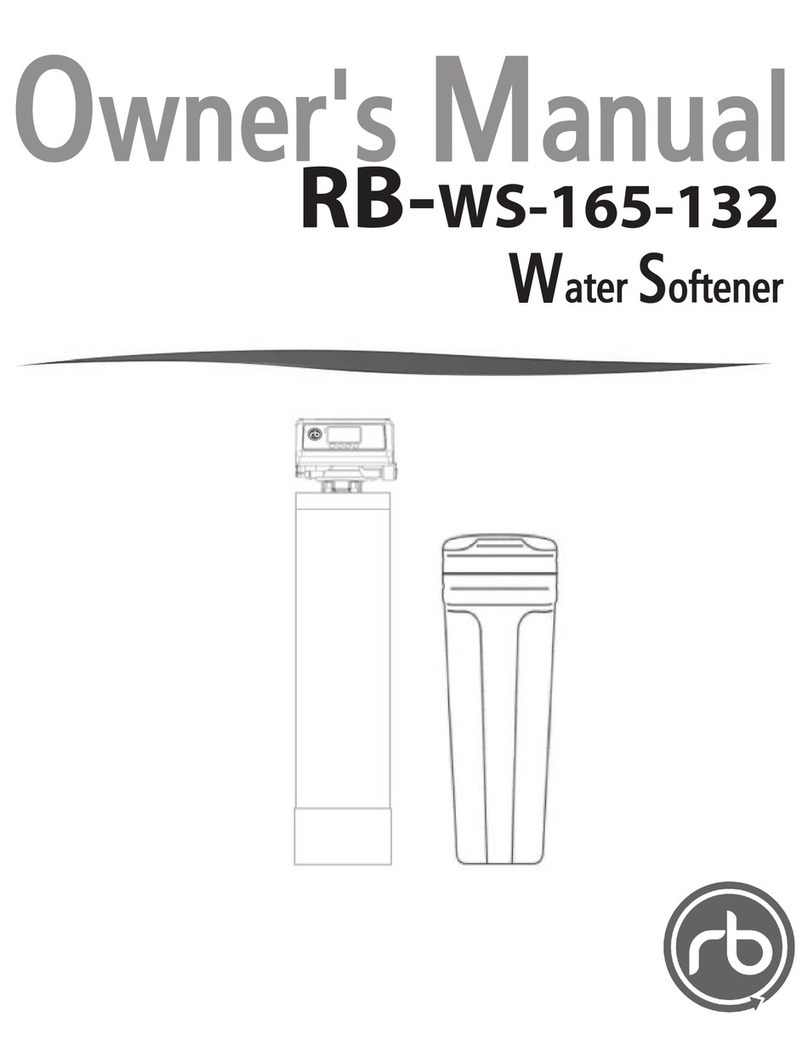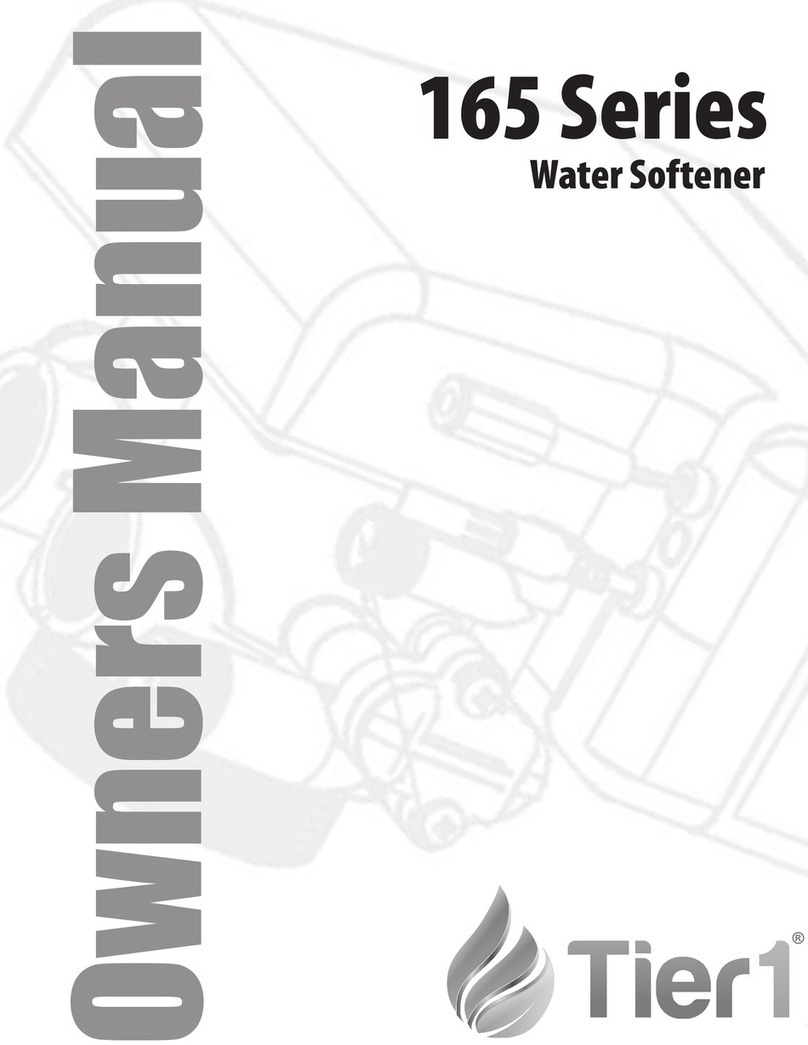
EFFICIENCY STATEMENT IAPMO R & T Certified
against CSA B483.1
PERFORMANCE DATA SHEET
MODEL NUMBER WH-HD-IRN-MG-948 WH-HD-IRN-MG-1054
Oty High Capacity Resin 1.0 1131.5 ftl
Rated Service Flow (gpml 10 12
Pressure Drop at Rated Service Flow (ps1J 15.0 15.0
Rated Softening Capacity lgrainsJ 13,629 Kl 3lbs 20,4A3 Kl 4.5lbs
Eciency (grams/lb sail) 4,543 4,543
Max.Flow Rate to Oram lgpml 2.0 2.4
Working Pressure Min.20 • Max. 125 psi
Operaung Temperature Mm 39 • Max.100 degrees Fahrenheit
1. Dissolved Iron—Also called ferrous or“clear water”iron. This type of iron can be removed from the water by the same ion exchange principle that removes the
hardness elements, calcium and magnesium. Dissolved iron is soluble in water and is detected by taking a sample of the water to be treated in a clear glass. The
water in the glass is initially clear, but on standing exposed to the air, it may gradually turn cloudy or colored as it oxidizes.
2. Particulate Iron—Also called ferric or colloidal iron. This type of iron is an undissolved particle of iron. A softener will remove larger particles, but they may not
be washed out in regeneration effectively and will eventually foul the ion exchange resin. A filtering treatment will be required to remove this type of iron.
3. Organic Bound Iron—This type of iron is strongly attached to an organic compound in the water. The ion exchange process alone cannot break this attachment
and the softener will not remove this type of iron.
4. Bacterial Iron—This type of iron is protected inside a bacteria cell. Like the organic bound iron, it is not removed by a water softener.
Water softeners remove hardness in the water by exchanging particles in the water, or ions. They remove hard ions such as calcium and magnesium in the water by trading it
for sodium ions producing soft water. Unlike the calcium and magnesium, sodium stays dissolved in water and does not form a scale. Sodium also does not interfere with the
cleaning action of soaps. The sodium is released by a charged resin contained in the softener, this resin also traps the calcium and magnesium ions. Eventually this resin releases
all of its sodium and has filled up with other ions, so it then must be regenerated. Regeneration is accomplished by washing the resin with a salt saturated brine solution that
removes the calcium and magnesium while replenishing the sodium. This is why the softener requires a brine tank and salt. The water softener can run for days before running
out of sodium, and when it does, the sodium is replenished in only a matter of a few hours
When using a softener to remove both hardness and dissolved iron it is important that it regenerates more frequently than ordinarily would be calculated for hardness removal
alone. Although many factors and formulas have been used to determine this frequency, it is recommended that the softener be regenerated when it has reached 50–75% of the
calculated hardness alone capacity. This will minimize the potential for bed fouling.
If you are operating a water softener on clear water iron, regular resin bed cleaning is needed to keep the bed from coating with iron. Even when operating a softener on water
with less than the maximum of dissolved iron, regular cleanings should be performed. Clean every six months or more often if iron appears in your conditioned water supply. Use
resin bed cleaning compounds carefully following the directions on the container.
CAUTION!
Do not use where the
water is microbiologically
unsafe or with water of
unknown quality without
adequate disinfection
before or after the unit.
This product is efficiency rated according to NSF/ANSI 44. The stated efficiencies are valid only at the specified salt dosages and maximum service flow rate.
These softeners conform to NSF/ANSI 44 for the specific performance claims as verified and substantiated by test data. These models are efficiency rated.The efficiency rating is valid only at the
stated salt dose and maximum service flow rate. They have a demand initiated regeneration (D.I.R.) feature that complies with specific performance specifications intended to minimize the amount
of regenerant brine and water used in their operation.These softeners have a rated softener efficiency of not less than 3350 grains of total hardness exchange per pound of salt (based on sodium
chloride) and shall not deliver more salt than their listed ratings.The rated salt efficiency is measured by laboratory tests described in NSF/ANSI Standard 44. These tests represent the maximum
possible efficiency that the systems can achieve. Operational efficiency is the actual efficiency after the system has been installed. It is typically less than the efficiency due to individual application
factors including water hardness, water usage, and other contaminants that reduce the softener’s capacity. These systems are not intended for use with water that is microbiologically unsafe or of
unknown quality without adequate disinfection before or after the system. Refer to Installation/operation manual and warranty for further details on installation, parts and service, maintenance
and further restrictions or limitations to the use of the product.
Why Water Gets Hard And How It Is Softened
All of the fresh water in the world originally falls as rain, snow, or sleet. Surface water is drawn upward by the sun, forming clouds. Then, nearly pure and soft as it starts to fall,
it begins to collect impurities as it passes through smog and dust-laden atmosphere. And as it seeps through soil and rocks it gathers hardness, rust, acid, unpleasant tastes and
odors.
Water hardness is caused primarily by limestone dissolved from the earth by rainwater. Because of this, in earlier times people who wanted soft water collected rainwater from
roofs in rain barrels and cisterns before it picked up hardness from the earth.
Some localities have corrosive water. A softener cannot correct this problem and so its printed warranty disclaims liability for corrosion of plumbing lines, fixtures or appliances.
Iron is a common water problem.The chemical/physical nature of iron found in natural water supplies is exhibited in four general types:
HOW WATER SOFTENERS WORK
Water hardness is caused primarily by limestone dissolved from the earth by rainwater. Iron is a common water
problem. The chemical/physical nature of iron found in natural water supplies is exhibited in four general types:
1. Dissolved Iron—Also called ferrous or “clear water” iron. This type of iron can be removed from the water by the same ion
exchange principle that removes the hardness elements, calcium and magnesium. Dissolved iron is soluble in water and
is detected by taking a sample of the water to be treated in a clear glass. The water in the glass is initially clear, but on
standing exposed to the air, it may gradually turn cloudy or colored as it oxidizes.
2. Particulate Iron—Also called ferric or colloidal iron. This type of iron is an undissolved particle of iron. A softener will
remove larger particles, but they may not be washed out in regeneration effectively and will eventually foul the ion
exchange resin. A ltering treatment will be required to remove this type of iron.
3. Organic Bound Iron—This type of iron is strongly attached to an organic compound in the water. The ion exchange process
alone cannot break this attachment and the softener will not remove this type of iron.
4. Bacterial Iron—This type of iron is protected inside a bacteria cell. Like the organic bound iron, it is not removed by a
water softener.
Water softeners remove hardness in the water by exchanging particles in the water, or ions. They remove hard ions
such as calcium and magnesium in the water by trading it for sodium ions producing soft water. Unlike the calcium
and magnesium, sodium stays dissolved in water and does not form a scale. Sodium also does not interfere with
the cleaning action of soaps. The sodium is released by a charged resin contained in the softener, this resin also
traps the calcium and magnesium ions. Eventually this resin releases all of its sodium and has lled up with other
ions, so it then must be regenerated. Regeneration washes the resin with a salt saturated brine solution to remove
the calcium and magnesium while replenishing the sodium. The water softener can run for days before running out
of sodium, and when it does, the sodium is replenished in only a matter of a few hours.
When using a softener to remove both hardness and dissolved iron it is important that it regenerates more
frequently than ordinarily would be calculated for hardness removal alone. It is recommended that the softener
be regenerated when it has reached 50–75% of the calculated hardness alone capacity. This will minimize the
potential for bed fouling.
If you are operating a water softener on clear water iron, regular resin bed cleaning is needed to keep
the bed from coating with iron. Even when operating a softener on water with less than the maximum
of dissolved iron, regular cleanings should be performed. Clean every six months or more often if iron
appears in your conditioned water supply. Use resin bed cleaning compounds carefully following the
directions on the container. Note: Inlet water which contains measurable levels of chlorine or
chloramines may adversely affect the resin life.




















